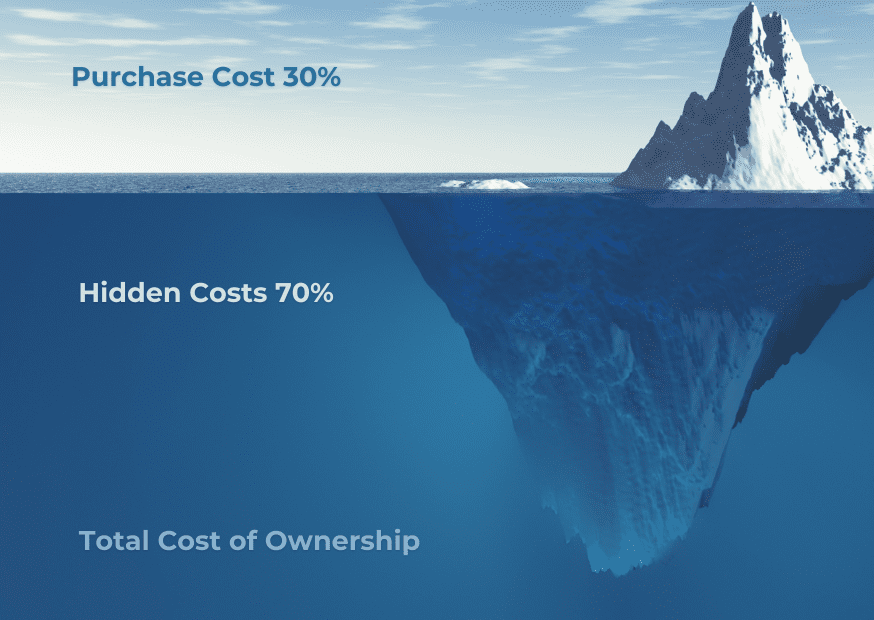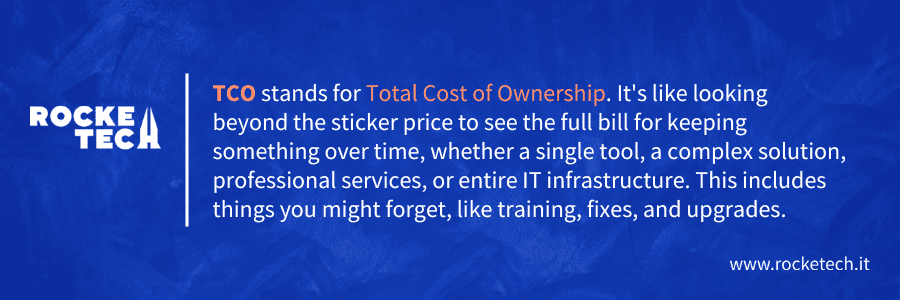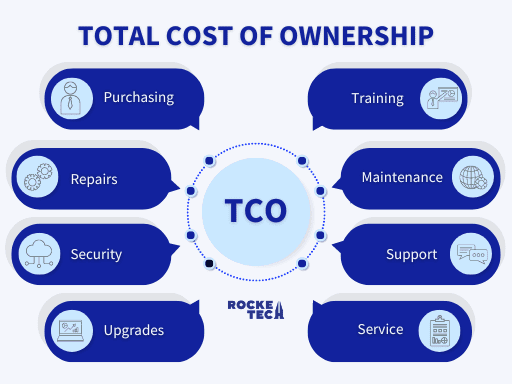When a business needs a digital product, there are usually two ways to approach this: buying a ready solution or building one from scratch. The second option often scares business owners as custom software development is still associated with large bills and long, tiring projects. But is this the reality today? What is the total cost of ownership for software?
We summed up everything you need to know about how much it all costs in the long run — the TCO of software.

What is the Total Cost of Ownership (TCO)?
In business, the Total Cost of Ownership (TCO) for software means looking at all the expenses beyond the initial purchase price. It covers everything from installation and training to ongoing maintenance, upgrades, and support.
TCO helps companies make informed decisions by considering the full cost of owning and using software over its entire lifespan, not just the upfront cost.
The total cost of ownership includes:
- The initial purchase price of the item;
- Ongoing license fees;
- Maintenance and repair costs;
- Indirect expenses like installation, training, and support.
These costs can add up significantly over a product’s or system’s lifespan. The total cost of ownership (TCO) idea is usually attributed to the Gartner Group which applied it to the computer and software industries in the late 1980s. The term has since spread to other industries. Accurately calculating TCO is crucial, especially when choosing corporate IT systems, which are becoming more complex and include many components.

Breaking Down the TCO in Detail: What Are the Cost Types?
If put simply, the TCO of software includes all costs associated with a product throughout its entire lifecycle — software, hardware, training, and support.
When buying new IT products, you can expect higher expenses in three key areas: acquisition, operational, and human resource costs. Here’s about it in more detail.
1. Acquisition Costs
Acquisition costs cover the initial purchase price and setup expenses for software or apps. These costs can also cover:
- Software licenses or subscriptions
- On-site equipment installation
- Employee training
Additional acquisition costs might include:
- IT infrastructure migration
- Research and development
- Legal services
- Testing
- Setup and installation
2. Operational Costs
Operational costs are the recurring expenses needed to keep the software running throughout its lifecycle. These include:
- Maintenance
- Support services
- Software updates
- Security measures
- Data backups
- Bug fixes
- License renewals
3. Human Resource Costs
Often overlooked, human resource costs are essential to consider. You need skilled personnel to manage and operate the software continuously. This results in additional expenses for:
- Training
- Onboarding
- Compensation
Understanding the types of costs associated with TCO makes it clear that TCO is far more comprehensive than just an initial one-time payment for a SaaS product or any IT solution. When a business starts using a seemingly ready product, there are numerous additional expenses to consider beyond the initial purchase.

How is the Total Cost of Ownership Calculated?
Calculating the total cost of ownership for enterprise software involves understanding and accounting for all costs associated with acquiring and operating an IT system throughout its lifecycle. The two most common methodologies for calculating TCO are the Microsoft and Interpose method and the Gartner Group method.
Microsoft and Interpose Method
This method divides all costs into direct and indirect.
Direct costs are clear expenses that decision-makers typically consider when budgeting:
- Software purchase or rental, implementation, configuration, and upgrades
- System and network design and administration
- Support staff salaries, employee training, outsourced support services
- Application development and testing, technical documentation preparation
- Establishing and maintaining communication channels
Indirect costs are often overlooked in budgeting but can account for over 50% of a company’s IT expenses according to Interpose:
- Informal user training and personal support for key clients
- Costs from temporary work disruptions, such as equipment failures or planned maintenance
Gartner Group Method
This method divides costs into capital expenses (CAPEX) and operational expenses (OPEX).
| CAPEX | OPEX |
|---|---|
| Development and implementation project costs | System updates and upgrades |
| Consultant fees during project creation | Management costs |
| Purchase, installation, and configuration of hardware/software | Costs related to user activity |
While capital expenses are one-time costs to set up an IT system, the business will have operational expenses throughout the software’s lifecycle to keep it running.
Total Cost of Ownership Formula
There are different ways of calculating the TCO for software, but the general formula is:
TCO = Purchase Cost + (Operational Expenses × Time)
While this formula seems simple, multiple internal and external factors affect the final TCO. Here’s what business owners should always keep in mind:
- Identifying all operational cost factors can be complex.
- Different software or services might have varied cost structures.
- Economic conditions like growth, inflation, or recession can impact TCO.
When making IT investments, it’s easy to focus on the initial price tag, but that’s just the tip of the iceberg. Total Cost of Ownership (TCO) reveals the true cost of your investments, from purchase to operation and maintenance.
To get an accurate picture, you need to team up with finance and consider all the expenses involved. With a clear understanding of TCO, you’ll be empowered to make informed decisions that drive your business forward.
Our experts will calculate them for you.
White-Label and SaaS Vs Custom Software: Is Cost Comparison Possible?
Imagine a common situation most business owners or C-level execs face today: Your company is to decide between buying a white-label or SaaS product and investing in custom software development. Let’s explore a hypothetical scenario and a total cost of ownership example to illustrate the key considerations.
💡 The Scenario
Your company is in a steady-growth phase and naturally needs a CRM system to manage your sales team’s activities. You’ve received two proposals:
a) Use a white-label CRM solution for $500 + a percentage of revenue
b) Develop a custom CRM system at a significantly higher cost (10 times more)
Most owners would go straight to a ready product thinking it’ll help them save time and money. While it seems logical, here are four questions you should ask yourself before making this decision.
📌 Question 1: What is your company’s long-term strategy?
Do you prioritize short-term profits (dividend strategy) or aim to grow your company for a potential sale (growth strategy)?
If you plan to sell your business, owning intellectual property (IP) and assets is crucial. Put simply, if you don’t have your proprietary code, you have nothing to sell.
Conclusion: A ready solution is not a good option if you plan to sell your business eventually.
📌 Question 2: How well does the white-label solution align with your plans?
From the developer’s perspective, offering a ready-made solution on a subscription basis is ideal, and additional paid customizations seem like a bonus. However, extensive customizations for a single client can interfere with the development of the core product, complicate support, and distract the team, leading to mutual dissatisfaction.
From the client’s perspective, the situation isn’t ideal either. They end up paying for the development of someone else’s product — the product they will never own.
Conclusion: A ready-made solution is an excellent choice if it meets almost 100% of your needs. Otherwise, there is a risk of encountering problems within a few months and getting the TCO for SaaS products exceeding the budget.
📌 Question 3: What is your product vision based on?
If the product relies on assumptions and hasn’t yet been tested on real users, investing in a fully developed, expensive solution will likely be a disaster. The primary goal here is to test hypotheses and gather user feedback quickly and inexpensively.
There are two approaches to choose from in this scenario:
- Finding a ready but flexible and customizable solution;
- Quickly building and launching a minimum viable product (MVP).
The difference here is that when building an MVP, the entire product belongs to your business from the beginning. It means much easier customizations, any pivots dictated by external factors, and proprietary code as your IP asset.
📌 Question 4: How easily can you exit the ready-made solution?
It’s vital to know that you can easily and painlessly say bye to your ready-made solution. It means a seamless transition out of the solution while being able to extract your data in a convenient format. Be cautious of vendors who may limit your access or data ownership.
Conclusion: If your business deals with sensitive data, ready products might pose multiple threats connected to its safety.
Expert Insight: User Needs and Product Customization
When calculating the TCO for IT systems, think not just about money but also about user experience and customization needs.
| Regardless of your target user base, don’t overlook distribution. Effective distribution ensures the system is accessible and usable by its intended audience, significantly impacting its overall cost and effectiveness. |
Customizing the product to meet specific client requirements is often more valuable than a ready-made solution. Many businesses buy off-the-shelf software but neglect to tailor it to their needs. And it always has consequences.
Take “ShopEase,” a mid-sized e-commerce company upgrading its inventory management system. They choose a popular off-the-shelf solution, thinking it will save time and money. However, the software doesn’t integrate well with their existing sales platform, leading to data discrepancies and frustrated employees.
💡 ShopEase decides to customize the software. They hire a developer to integrate it seamlessly with their sales platform and add features like real-time stock updates and automated reorder alerts.
This customization incurs additional costs, but the benefits are clear. Employees find the system easier to use, reducing training time and errors. Real-time updates improve inventory accuracy, preventing stockouts and overstock situations. Ultimately, these improvements lead to better customer satisfaction and increased sales.
Final Thoughts
When the time comes for a business to invest in a software product, it’s natural to try to save up, and a ready product may seem like a cost-effective option. However, many startup founders and small business owners overlook SaaS customization costs, maintenance, and even employee training that make up the total ownership cost.
In contrast, custom software development is an investment. It offers a tailored solution that aligns with your specific business needs. While the upfront investment may be higher, you avoid paying for unnecessary features and benefit from seamless integrations handled by the same experts who developed your software. This approach also enables continuous feedback and improvement, reducing training costs.
As businesses evolve, SaaS solutions may no longer suffice. Custom software development provides a scalable solution that adapts to your growing needs. When evaluating software options, consider the software ownership’s long-term costs and benefits.
but unsure about the final price?
Get the first estimate for free.